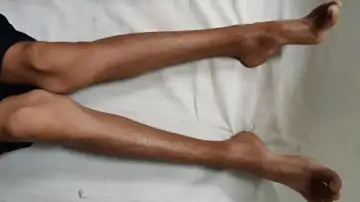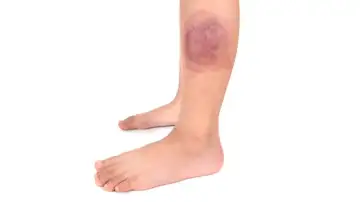We often think of rickets and worm infections as illnesses from our grandparents’ time, but they’re making a comeback in today’s cities.
The causes are surprisingly modern; children spending most of their time indoors with little sun exposure, diets low in calcium and vitamin D, and hygiene lapses linked to crowded living spaces, street food, and patchy sanitation. The result is a double burden-bone disease on one hand, and chronic, often hidden parasitic infection on the other, both of which undermine growth, school performance, and long-term health.
We spoke to Dr Vittal Kumar Kesireddy, Consultant and In-charge, Department of Paediatrics, CARE Hospitals, Banjara Hills, Hyderabad, who explained the rising causes of rickets and worm infections in children.
Why Is Rickets Resurfacing In Cities?

Rickets results from a prolonged deficiency of vitamin D, calcium, or both, and it remains prevalent in areas where children spend limited time outdoors or have a diet lacking in essential nutrients. Numerous large-scale studies and reviews conducted in South Asia have reported a high prevalence of among infants, children, and adolescents.
“Urban residence is consistently identified as a risk factor, primarily due to factors, such as indoor schooling, high-rise living, cultural practices that involve avoiding sun exposure, and air pollution that reduces UVB penetration. Clinical rickets manifests when the deficiency is severe, but earlier biochemical deficiencies, such as low serum 25-hydroxyvitamin D levels, are widespread and clinically significant,” said Dr Kesireddy.
The sunlight paradox is significant: incidental outdoor play, which once provided most of the vitamin D needed, is now less common. Brief, regular exposure to sunlight around midday efficiently triggers skin synthesis, but modern routines rarely accommodate this. “As a result, public health guidance emphasises both sensible sun exposure and targeted supplementation, particularly in infants and young children, since dietary sources alone are often insufficient. National pediatric societies recommend routine vitamin D prophylaxis during infancy and specific treatment protocols for children with deficiencies to reverse rickets and restore bone health,” added Dr Kesireddy.
How Urban Children Pick Up Worms

Soil-Transmitted Helminths (STH), including roundworm, whipworm, and hookworm, remain among the most common childhood infections worldwide. Although traditionally associated with rural poverty, STH persists in urban settings where sanitation is inadequate, food handling is poor, or families reside in overcrowded, informal housing.
“Children acquire these parasites by ingesting contaminated soil, consuming unwashed produce, or through barefoot exposure to infected ground; behaviors such as pica (eating earth) and inadequate hand hygiene increase the risk. Large pooled analyses reveal significant STH prevalence in school-age children across various regions, highlighting that urban residence does not guarantee protection,” explained Dr Kesireddy.
Worm infections sap nutrition subtly yet powerfully. Heavy burdens lead to anaemia, poor weight gain, stunting, and impaired cognitive development. Even low-intensity infections interfere with appetite and micronutrient absorption, so recurrent or untreated infection can erode resilience even in otherwise well-fed children.
Spotting the Signs Early
Rickets
- Visible signs: Bowed legs, delayed walking, widened wrists, costochondral beading (prominent ribs), delayed fontanelle closure in infants.
- Early subtle clues: Poor growth velocity, muscle weakness, recurrent respiratory infections.
- Laboratory evaluation: Serum calcium, phosphate, alkaline phosphatase, and 25-hydroxyvitamin D levels.
- Imaging: X-rays of wrists and knees show classic metaphyseal changes in established rickets.
Helminth infection
- Suspect with: Persistent gastrointestinal complaints, poor weight gain, pallor, and visible worms in stool.
- Diagnosis: Stool microscopy is the basic diagnostic tool.
- Public health approach: Periodic, population-level deworming in endemic settings due to the impracticality of testing every child.
Practical, Evidence-Based Steps Families and Clinicians Can Take

- Encourage safe, regular outdoor play-short daily midday sun exposure tailored to skin type, while balancing skin cancer risk.
- Ensure age-appropriate vitamin D supplementation as per paediatric guidance,
- Promote calcium-rich foods (dairy, fortified products, green leafy vegetables) alongside a varied diet.
- For worm prevention, routine handwashing, hygienic food preparation, proper disposal of faeces, and wearing footwear reduce transmission.
- In areas with known endemicity, school-based or community deworming programs, together with improved sanitation, remain cornerstone strategies endorsed by global health authorities.
What Can Clinicians Do?
- Clinicians should maintain a low threshold for screening in at-risk children.
- Measure serum 25-OH vitamin D and basic bone labs in those with growth faltering or skeletal complaints.
- Perform stool testing when gastrointestinal symptoms or anaemia persist.
Treatment reverses many effects: therapeutic vitamin D restores mineralisation, and single-dose or short-course anthelmintics clear most common helminths when given according to age and weight. Follow-up ensures recovery and prevents recurrence.
Bottomline
Dr Kesireddy concluded, “The resurgence of rickets and worm infections in urban clinics serves as a reminder that modern parenting choices, such as screen-bound routines, packaged diets, and inconsistent hygiene, can recreate ancient health risks. The good news is that both conditions are preventable and treatable. By implementing practical changes at home, providing routine infant supplementation, promoting school hygiene, and conducting community deworming where necessary, these problems can be halted before they have long-term consequences for bone and overall health.”
